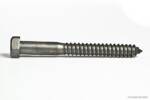Newest FAQs
The anchor rods in this photo were damaged because they were covered with snow and the equipment operator did not see them. Every situation is different, and we try to not make recommendations where bent anchors are concerned as we feel it is a question better answered by the project engineer, as he/she will be... Read more
Several ASTM specifications are followed by an “M” that denotes it being an equivalent metric standard. While there is actually an A193M Grade B7 specification which is applicable to metric fasteners, this is not the case with ASTM A193 Grade B7M. This is a different grade of material than A193 Grade B7. So how exactly... Read more
The answer to this question is no. The ASTM F1554 specification defines tolerance ranges for various dimensional requirements such as thread dimensions, thread length variance, overall length, (and in the case of bent anchor bolts) bend section, hook length, and bend length. However, no tolerances are given for straightness. The reason for this is because... Read more
A lag screw, also referred to as a lag bolt, is a heavy wood screw with a spiral thread and a hex or square head used for driving it into wood. Large diameter lag screws typically do not require gimlet points because of the need for a pilot hole to lower the torque required to... Read more

ASTM A123 does not cover threaded bolts and fasteners. ASTM A153 and F2329 are the ASTM specifications that cover the requirements for hot-dip zinc coating of fasteners. ASTM A123 This specification covers the requirements for hot-dip galvanizing on iron and steel products made from rolled pressed and forged shapes, castings, plates, bars, and strips. It... Read more
The following terms are measurements of strength that are commonly used in the fastener industry. All ASTM and SAE graded fasteners possess requirements for some or all of these strength characteristics. Our Strength Requirements by Grade Chart will provide a list of these strength requirements for each specification. Yield The yield strength or yield point of... Read more
ASTM A588 is a common steel standard that covers high strength, low-alloy structural steel shapes, plates, and bars with improved atmospheric corrosion resistance that is intended for riveted, bolted, or welded construction. Fasteners are not specifically included in the scope of A588, but that doesn’t stop engineers and contractors from asking for A588 bolts. Why is... Read more
ASTM A572 is a common structural steel standard that covers five grades (42, 50, 55, 60, 65) of high strength, low-alloy structural steel shapes, plates, and bars that is intended for riveted, bolted, or welded construction. Fasteners are not specifically included in the scope of A572, but that doesn’t stop engineers and contractors from asking for... Read more
ASTM A36 is a very common steel standard that covers structural carbon steel shapes, plates and bars. Fasteners are not specifically included in the scope of A36, but that doesn’t stop engineers and contractors from asking for A36 bolts. Why is that an issue? The inherent problem with trying to order bolts to a ASTM... Read more
Both ASTM F568M and ISO 898-1 outline several grades of metric fastener, from low carbon/low strength, up to high strength/heat treated alloy grades. The equivalents listed below should be only considered as rough equivalents. Special care should be taken before substituting grades to make sure that an acceptable substitute is being used. For example, grade... Read more
